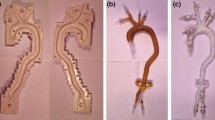Abstract
The two most common types of coronary perfusion cannulae currently being used are the “balloon type”, with a balloon at the tip, and the “fenestrated type”, which has holes along the side near the tip. However, on occasion an unusually high perfusion pressure or a considerable amount of leakage is encountered during infusion of the cardioplegic solution. We have examined the properties of a newly developed Kochi Medical School (KMS)-type cannula and compared these to the properties of the balloon-type and fenestrated-type cannulae in an ex vivo experimental model that contains ostia of 4, 3, or 2 mm in diameter. Ejected flow velocity, circuit pressure, and the amount of leakage were measured at an infusion rate of 100 and 200 mL/min, with the latter two parameters measured under the counterpressure of 0 and 50 cmH2O to examine the influence of coronary vascular resistance. Without counterpressure, the balloon type presented with the highest flow velocity (263 cm/s at 200 mL/min) and perfusion pressure (64 mmHg at 200 mL/min) but without leakage. The fenestrated type yielded a considerable amount of leakage (40 % at an ostium size of 2 mm). The KMS type showed a lower flow velocity and circuit pressure with less leakage. Under 50 cmH2O counterpressure, however, only the KMS-type cannula could inject the water to any ostium size at both flow rates. These results suggest that the concept of the KMS-type cannula may be advantageous to achieving a secure infusion to a diseased coronary ostium.




Similar content being viewed by others
References
Nakano M, Matsui M, Okuyama H, Isii S, Itoh T, Kurosawa H. Successful patch angioplasty for the right coronary artery dissection following selective coronary perfusion (in Japanese). Kyobu Geka. 1994;47:123–7.
van Putte BP, Vink A, De Bruin PC, Defauw JJA. Selective antegrade cardioplegic perfusion complicated by left main stem dissection. J Cardiovasc Surg (Torino). 2007;48:247–8.
Ishino K, Murakami T, Teramoto S. Cannulation-induced coronary artery dissection: successful management with circulatory assist devices and coronary bypass grafting. Surg Today. 1998;28:563–6.
Chavanon O, Carrier M, Cartier R, Hébert Y, Pellerin M, Perrault LP. Early reoperation for iatrogenic left main stenosis after aortic valve replacement. Cardiovasc Surg. 2002;10:256–63.
Maltais S, El-Hamamsy I, Ducharme A, Carrier M, Pellerin M, Perrault LP. Late iatrogenic coronary stenosis after selective intraoperative antegrade myocardial protection for stentless aortic valve replacement. J Thorac Cardiovasc Surg. 2006;132:420–1.
Midell LL, Deboer A, Bermudez G. Postperfusion coronary ostial stenosis. J Thorac Cardiovasc Surg. 1976;72:80–5.
Author information
Authors and Affiliations
Corresponding authors
Rights and permissions
About this article
Cite this article
Kondo, N., Yamamoto, M., Kihara, K. et al. Development of a new selective coronary perfusion cannula. J Artif Organs 16, 411–416 (2013). https://doi.org/10.1007/s10047-013-0721-5
Received:
Accepted:
Published:
Issue Date:
DOI: https://doi.org/10.1007/s10047-013-0721-5




